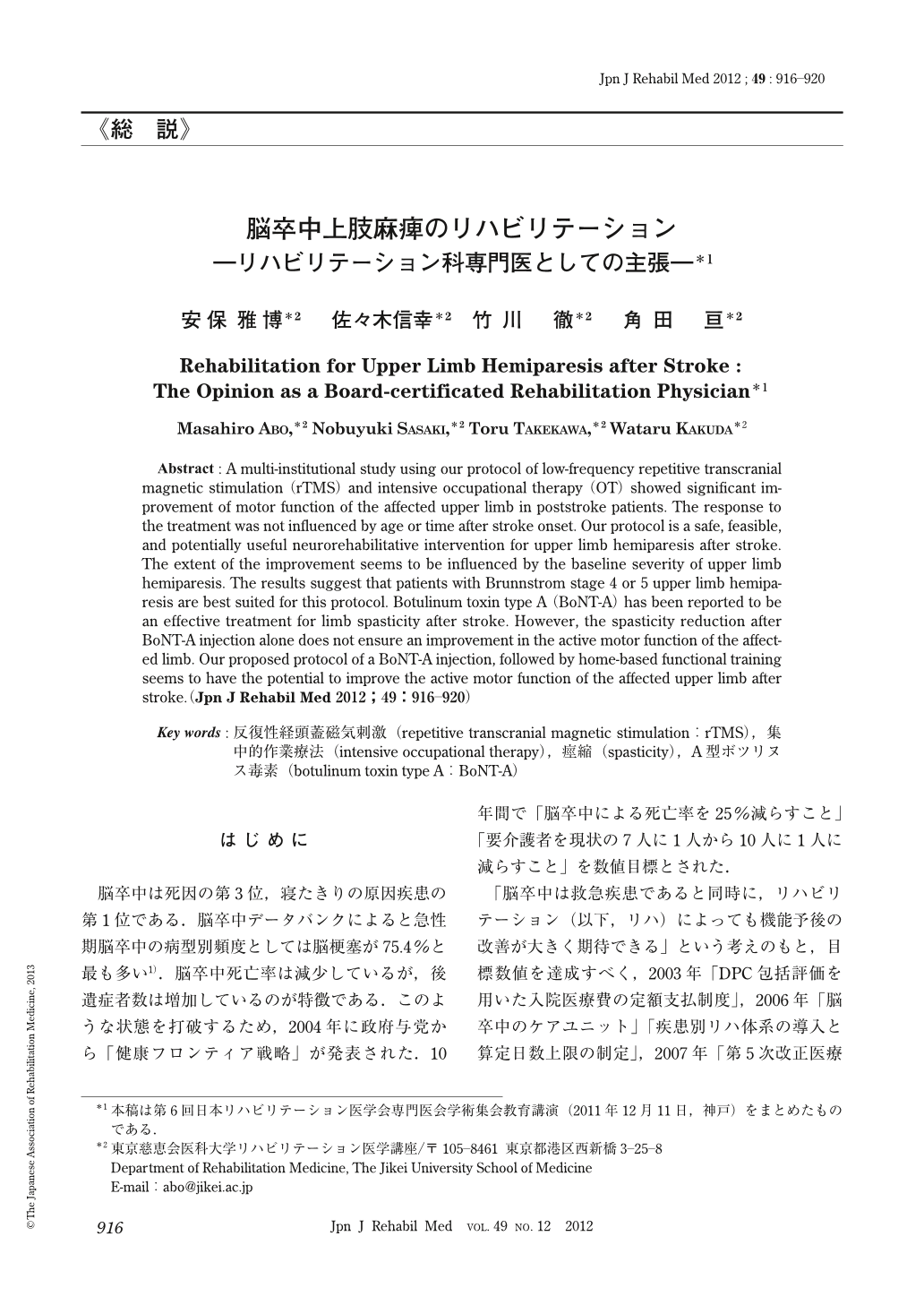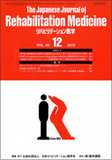Japanese
English
- 販売していません
- Abstract 文献概要
- 1ページ目 Look Inside
- 参考文献 Reference
はじめに
脳卒中は死因の第3位,寝たきりの原因疾患の第1位である.脳卒中データバンクによると急性期脳卒中の病型別頻度としては脳梗塞が75.4%と最も多い1).脳卒中死亡率は減少しているが,後遺症者数は増加しているのが特徴である.このような状態を打破するため,2004年に政府与党から「健康フロンティア戦略」が発表された.10年間で「脳卒中による死亡率を25%減らすこと」「要介護者を現状の7人に1人から10人に1人に減らすこと」を数値目標とされた.
「脳卒中は救急疾患であると同時に,リハビリテーション(以下,リハ)によっても機能予後の改善が大きく期待できる」という考えのもと,目標数値を達成すべく,2003年「DPC包括評価を用いた入院医療費の定額支払制度」,2006年「脳卒中のケアユニット」「疾患別リハ体系の導入と算定日数上限の制定」,2007年「第5次改正医療法」,2008年「医療費適正化計画」「脳卒中医療連携体制全体としての入院日数の削減」「脳卒中を対象とした地域連携診療計画管理料および地域連携診療計画退院指導料」など改正が行われ,東京都の回復期病院のベッド数も保険点数の後押しを受け,2008年4月に2,744床がわずか2年の間に3,908床になり,現在は軽く4,000床を超えるに至った.よって,回復期病院は,訓練量はいうまでもなく訓練の質を問われる時代になり,今後勝ち組あるいは負け組とはっきりと色分けされるだろう.
脳卒中になったときの患者の主なリハ科医への問いは,1.歩けるようになるのですか? 2.手が使えるようになりますか? 3.話せるようになりますか? に集約される.しかしながら,上下肢の麻痺に関して言えば,発症後3カ月の間が最も機能障害の改善する期間であり,日常生活動作(ADL)も改善する期間が限られている2).特に,最初の1カ月間は最も改善する期間であるので,全身状態が落ち着けば,量的にも質的にも高い訓練を受ける必要がある.よって,座位がとれるようになれば回復期であると定義し,脳卒中パスを使って,回復期担当病院に転院すべきということになる3,4).回復期病院の最も重要な役割は,早期に量,質とも高いリハ施行して患者を自宅に帰すことである.自宅に患者が戻る一番の条件が排尿排泄の自立であるので,移動,歩行訓練主体のADL自立の訓練が主体になる.
脳卒中後遺症による上肢の麻痺は,プラトーに達したのは,重度麻痺で6週で80%,11週で95%,軽度麻痺では3週で80%,6週で95%である.歩けるけれども手が使えない人がいかに多いかを表している5).脳卒中リハに関しては,2006年,診療報酬改定で,病院でのリハは病気ごとに日数制限を受け,脳卒中・脳炎などの脳疾患=発症や手術から180日(重症患者は一部除外)までしか受けられなくなった.しかしながら,医療機関の猛反発から2007年4月には,医師から改善の見込みありと判断された患者は180日を超えたリハが可能になった.また,2008年4月からは180日を超えた場合でも医師の判断で1回20分のリハを1カ月13回まで受けられるように緩和された.この制度も2014年4月からなくなってしまう.いわゆるこの180日ルールつまりは,「維持期や慢性期では脳卒中後遺症はよくならない」というのは,残念ながら,いままでのデータから見れば,現在の定説では妥当としか言いようがない.
このような状況の中,以前から日本リハ医学会で指摘されていたことだが,2010年にようやく,リハ科医が最も日本の中で不足していることが新聞各紙で,報道された.しかしながら,救急科や小児科のように問題として取り上げられることは皆無であった.リハ科は内科や外科と同様の標榜診療科であり,学会は「日本専門医制評価・認定機構」に定められている基本領域18学会の1つである.私を始め,非常に悲しくやるせない気持ちになったリハ科専門医は多いのではないかと思う.
Abstract : A multi-institutional study using our protocol of low-frequency repetitive transcranial magnetic stimulation (rTMS) and intensive occupational therapy (OT) showed significant improvement of motor function of the affected upper limb in poststroke patients. The response to the treatment was not influenced by age or time after stroke onset. Our protocol is a safe, feasible, and potentially useful neurorehabilitative intervention for upper limb hemiparesis after stroke. The extent of the improvement seems to be influenced by the baseline severity of upper limb hemiparesis. The results suggest that patients with Brunnstrom stage 4 or 5 upper limb hemiparesis are best suited for this protocol. Botulinum toxin type A (BoNT-A) has been reported to be an effective treatment for limb spasticity after stroke. However, the spasticity reduction after BoNT-A injection alone does not ensure an improvement in the active motor function of the affected limb. Our proposed protocol of a BoNT-A injection, followed by home-based functional training seems to have the potential to improve the active motor function of the affected upper limb after stroke.

Copyright © 2012, The Japanese Association of Rehabilitation Medicine. All rights reserved.


